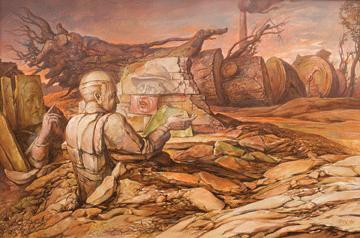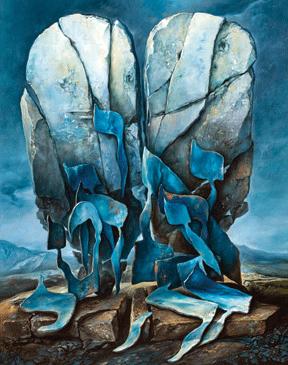
Since the tender age of 3, Samuel Bak has always known he would be an artist. A Jew born in Vilna, Poland, in 1933, the year Hitler came to power, he has said his paintings “come from a compulsive need to give meaning to the miraculous fact of my survival.”
Bak will be in Kansas City on Thursday, March 5, to speak about the paintings in “ILLUMINATIONS: The Art of Samuel Bak,” a collection of 20 paintings on loan from Facing History and Ourselves. The exhibit will open during First Friday on March 6 at the Leedy-Voulkos Art Center and runs through April 25. {mprestriction ids="1,3"}In addition, eight large paintings by Bak, selected for this exhibition by Bernie and Sue Pucker of the Pucker Gallery in Boston, will anchor the “ILLUMINATIONS” exhibit.
Bak’s art weaves together personal and Jewish history, symbolizing Bak’s Holocaust experience and his perceptions of a world that lives in the shadow of the crematoria chimneys. Across seven decades of artistic production, Bak has explored and reworked a set of metaphors, a visual grammar and vocabulary that ultimately poses metaphysical questions. His art depicts a world destroyed, and yet provisionally pieced back together.
Bak and the exhibit come to Kansas City through the efforts of his friend, colleague and Kansas City native Bernie Pucker (see story Page 9) and Professor Milton Katz of the Kansas City Art Institute.
“I have been teaching literature, art and film of the Holocaust for over three decades at the Kansas City Art Institute and have always wanted to bring to my students and the community an artist who survived the Shoah and continued to create fragments of this unspeakable memory in their work,” Dr. Katz said.
“Although I was familiar with his work for some time, it was only two years ago that I was fortunate to interview Samuel Bak and discuss his work with him at his home in Massachusetts. His passion, sensitivity and honesty created a poetic visual language that spoke to me, and I wanted others to experience it as well. “Through deeply engaging metaphors and symbols, his art depicts a world that was shattered, ruptured — physically, psychologically, spiritually and culturally. Yet, at the same time, you can both feel and see in his works a profound longing and belief in tikkun, a sacred obligation to help repair a post-Holocaust world,” Dr. Katz continued.
At the time Bak was born, he said Vilna was a community of 70 to 80,000 Jewish people that was a great center of modern Yiddish poetry and literature.
Once the war started, he was sent to the ghetto and eventually a labor camp, which was liberated by the Russians in 1944 when he was 11. His father and four grandparents all perished at the hands of the Nazis.
“I was very lucky that I survived with my mother and she was so concerned to find for me the proper teachers for art,” he said last week during a phone interview from his home in a suburb of Boston, where he has lived since 1993. No matter where they lived — Russia immediately after the war, a displaced persons camp in Germany, Israel — he studied art. After he served his compulsory army service in Israel, he studied at a variety of art institutions including the Bezalel Art School in Jerusalem and the École des Beaux Arts in Paris.
“Then I started a career as a painter, first in Rome, Italy, where I settled with my first wife and where my three daughters were born. Then I moved back to Israel, out of Israel, always concerned to be able to paint what I wanted to paint and also find a market for my work, which was indispensable for the continuation of my profession. I continued to consider myself very, very lucky because now as I’m over 80 I can say that I have for almost 60 years practiced painting and was able to always do that and only that and I feel extremely privileged about that,” Bak said.

In his mid-30s he decided he wanted his art to reflect the story of his life, “talk about the people who survived the huge catastrophe, talk about a world that has experienced the Holocaust.”
He doesn’t believe his paintings speak about the Holocaust, and he believes he is wrongly considered a Holocaust painter.
“I try to speak about a world which is trying to rebuild something out of the bits and pieces of things that were broken and go on existing and functioning. It was like this in the mid-‘60s that the type of painting that I am doing now, the language of painting that I am using now has kind of materialized and allowed me to explore many, many different subjects,” he said.
Much of the art being shown in Kansas City is part of “Illuminations: The Art of Samuel Bak,” that is installed at Facing History and Ourselves’ national office in Brookline, Mass. Visitors will be able to access an audio tour with commentaries by professor Lawrence L. Langer by using their cell phones.
Bak doesn’t personally like to verbalize exactly what his art says.
“I would like the people who come to see my work, to bring to it an open mind and an open imagination and try to look into the frames of the paintings that represent spaces in which things are happening. Many of my paintings speak of a world that was destroyed, a world that is being reconstructed with whatever means it is possible. They speak quite a lot about the human resilience. But they speak also about the human resilience with a certain sadness. The ongoing destruction in the world isn’t ending. This we see and this we know and this we read in the newspapers,” the artist explained.
“I have seen from my own experience that many people who come to see my work find in it a certain resonance with their own feelings, with their own imagination and they interact with it. The worst thing that I could do for these people to try to put in their mouth with a little spoon a recipe of how to understand my work or what it says.”
He does believe Langer has beautifully described his paintings in a way others can understand them. Dr. Katz also refers to Langer, and noted he loves what Langer once wrote about Bak’s paintings, “The strength of his vision is its refusal to commit to hope or despair. It reflects an art oscillating between expectation and dismay.”
In his own words, Katz added, “For me, it is this tension in his art that makes it so compelling and memorable. I am grateful for the help of Bernie Pucker and a host of others, and am proud to be bringing the art of Samuel Bak to our city.”
While it was his parents and close relatives who first saw his artistic talent and who decided he would be an artist at such a young age, Bak said being a painter has made him happy.
“I think it’s an incredible privilege to be able to be an artist and be able to do what one wants and to be able to speak in a language, which is international, that was fantastic.”
“To me having lost most of the family in the Holocaust, my grandparents and other members of the family … it is not because of that that I am an artist but it also helps me wonderfully well to know that I am doing something that was expected from me.”
Bak exhibit, presentation details
“ILLUMINATIONS: The Art of Samuel Bak,” a collection of 20 paintings on loan from Facing History and Ourselves, will open during First Friday on March 6 at the Leedy-Voulkos Art Center, located at 2012 Baltimore in Kansas City, Mo., and runs through April 25. Hours are 11 a.m. to 5 p.m. Thursday through Saturday. Eight additional large paintings by Bak, selected for this exhibition by Bernie and Sue Pucker of the Pucker Gallery in Boston, will anchor the “ILLUMINATIONS” exhibit. Both the artist and Pucker will be present at the opening. The exhibition is made possible with financial support from Bryan Cave LLP and the Sosland Foundation and is presented in cooperation with the Midwest Center for Holocaust Education.
On March 5, Bak will give a presentation of his work at 7 p.m. in Vanderslice Hall at the Kansas City Art Institute, 4415 Warwick Blvd., Kansas City, Mo. That event, which is free and open to the public, is co-sponsored by the Kansas City Art Institute and Congregation Beth Shalom.
Samuel Bak’s appearance in Kansas City is made possible by the Kansas City Art Institute; the Rabbi Gershon Hadas Memorial Lecture, a program of Congregation Beth Shalom; Jewish Federation; Jewish Community Center; and the Tzedakah Fund at Combined Jewish Philanthropies of Boston.{/mprestriction}



